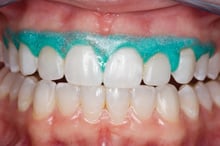It is perhaps unsurprising that the search term ‘teeth whitening’ is one which generates a great deal of interest from the public. With the rise of social media and smartphones, patients are increasingly searching for the picture-perfect smile. As dental professionals, it is our duty to understand not only the motivations of patients, but also their common concerns and queries.
In our latest blog, we explore five of the most common searched questions relating to teeth whitening; and examine what tools are available to assist with tooth whitening in practice, and at home.
1. How do Teeth Whitening products work?
The teeth whitening process is possible due to the ‘active ingredient’ in the product; which is usually hydrogen peroxide or carbamide peroxide. The active ingredient works by penetrating the enamel to get rid of discoloured molecules. It does this by releasing oxygen molecules, which react with the discoloured molecules; breaking down the bonds which hold them together. The oxygen molecules then spread, resulting in a whitened tooth.
 Whilst the process of teeth whitening is relatively straightforward; the concentrations of hydrogen peroxide and carbamide peroxide can be a source of patient confusion. It’s easy to see why. In search of a ‘Hollywood Smile’ or overnight results, patients might seek the strongest product. To a casual observer, this might be the product with the highest percentage.
Whilst the process of teeth whitening is relatively straightforward; the concentrations of hydrogen peroxide and carbamide peroxide can be a source of patient confusion. It’s easy to see why. In search of a ‘Hollywood Smile’ or overnight results, patients might seek the strongest product. To a casual observer, this might be the product with the highest percentage.
The reason why the strongest percentage does not equate to the highest strength is because carbamide peroxide breaks down during use; resulting in a strength equivalent to 1/3 of hydrogen peroxide. This is typically why, products containing carbamide peroxide such as Opalescence 10% CP or Opalescence 16% CP, will have longer wear times, as the gel stays active, breaking down throughout the night. Conversely, hydrogen peroxide maintains its original state, typically allowing for a shorter wear time.
It is important patients understand these differences, to correctly assess the intensity of the whitening products they choose.
Before Opalescence: After Opalescence:


2. Where can I get Teeth Whitening done?
With teeth whitening being advertised by mainstream celebrities; patients are increasingly turning to the internet to learn about teeth whitening procedures. There is a common misconception that teeth whitening is a cosmetic procedure; but as clarified by the General Dental Council, teeth whitening is ‘a dental treatment and not a cosmetic treatment’. As such, if a patient wants any teeth whitening procedure, they need to understand that:
“Only dentists, dental therapists, dental hygienists and clinical dental technicians working to the prescription of a dentist can legally perform tooth whitening”
(Source: The General Dental Council)

As a dental professional, of course you can recommend products to best suit your patients individual needs. Many patients wish to ‘kick start’ their teeth whitening treatment with an in-office whitening procedure. This has the advantage of professional supervision, and is often combined with a follow up at home whitening treatment. Opalescence offer an in-office patient kit which is perfect for this purpose; which could then be combined with a take home whitening kit such as Opalescence Go – a perfect option for those who are looking for convenient at home whitening.
3. Why does Teeth Whitening causes sensitivity?
It is commonly accepted that tooth sensitivity is a relatively common side effect of whitening. This can be due to several reasons, but most commonly; whitening temporarily causes microscopic exposed dentin. This pain usually reverses shortly after the whitening procedure, but can cause discomfort in the short term. For minor pain, a desensitizing toothpaste that contains potassium nitrate may help; however, for more moderate to severe cases, a product such as UltraEZ can provide patients with immediate sensitivity relief. Available in syringes, or disposable trays, the formula contains a sustained-release 3% potassium nitrate formula, delivering the patient with continued results.

4. Can Teeth Whitening burn your gums?
Temporary gum irritation is not uncommon when teeth whitening; product can easily be distributed to the soft tissues, resulting in inflammation. One way to overcome this when whitening in practice, is by use of a resin barrier such as OpalDam Green. Products such as this, are ideal for use in teeth whitening; isolating and protecting soft tissues with an impervious seal.




5. Can Teeth Whitening remove stains?
Both in office whitening treatments, and take-home office whitening treatments offer a potential solution to remove stains. However, for some patients superficial white and brown stains, cannot be removed through bleaching alone. For patients with this issue; products such as the Opalustre Kit can provide an answer. Utilising chemical stain removal, along with mechanical abrasion; the Opalustre Kit can remove superficial white and brown decalcification stains in just one appointment.
Before Opalustre: After Opalustre:


To find out more about Opalescence call us on +44 (0) 1943 60 50 50 or email sales@optident.co.uk

